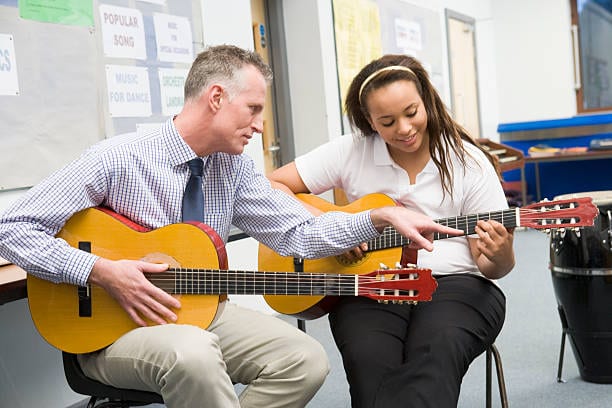We are often asked the best way to learn a new instrument – an instructional book? Youtube tutorials? Trial and error? They’re all acceptable methods, and they all have their advantages and disadvantages. In full disclosure, we have a small dog in this fight (though he’s a friendly dog). As music teachers ourselves, you’re probably a little skeptical – maybe we’re trying to sell you on something when we say that nothing beats face-to-face lessons? Not the case. We’re just here to report what we’ve learned from our time teaching music and learning it ourselves. Here are just a few benefits of face-to-face music lessons.
Interactivity
Sure, you can learn that riff from Sweet Home Alabama from a Youtube tutorial. It’s a great way to learn music from the comfort of your own couch, without anyone around to judge you! But when Howard (I’ll call him Howard) shows you where to put your fingers on the fretboard and strums a nice clean Cadd9 chord, you might strum a chord that sounds like a prelude to the apocalypse.
As far as you can tell, you’re pressing down the same strings that Howard is – so what’s the problem? I don’t know. Howard doesn’t know. Your spouse in the other room doesn’t know or care. And there’s your first problem – you can’t interact with Howard. In fact, he’s now 3 chords ahead of where you are, and he’s still talking like you’re following along. Nothing beats a teacher sitting across from you, showing you that you’ve got your index finger at the wrong fret.
Feedback
This is a similar (but slightly different) concept. Maybe now you’re playing exactly what Howard is playing, and you think it sounds great. A teacher sitting across from you might say, “Gosh, Jim… you’re strumming like you’re trying to put out a fire.” Technique is an important part of playing an instrument that is hard to teach without trial, error, and immediate feedback. A lot of times, when we think we’re doing something exactly like someone else, we’re missing some subtle details that might be more important than we realize.
Posture is a good example. When learning guitar, a lot of people will lean over to watch where their fingers are landing. There’s nothing wrong with this, but it is a habit you will eventually have to break if you want to play like Ed Sheeran – that’s who you guys look up to these days, right? But you might never realize this without someone to kindly point it out to you, and show you proper posture.
Checking In
Teaching yourself something is always a good thing – unless you’re teaching yourself to build bombs or something, I guess… but why would you even go there in a music blog? My point is: disciplining yourself to learn a new skill is usually a positive. The reality, however, is that most of us aren’t very good at disciplining ourselves. We go easy when we should be rigid. We convince ourselves that it’s okay to skip practicing for several days in a row. We eat peanut butter with a spoon and watch 2 hours of newscaster bloopers when we’re supposed to be watching a new guitar tutorial.
This is normal human behavior – when no one is around, we often sink into low-performance mode. Having a teacher to check in with once a week can be a great incentive to keep yourself on track. They can let you know whether you’re improving at a steady rate, or stalling. They can also inspire you to work harder, simply by demonstrating to you how a piece could be performed, if you keep working at it – and then giving you step-by-step instructions on how to achieve it yourself.
There are countless ways to learn how to do something, but it’s hard to beat the benefit of sitting face-to-face with another human being, and having them instruct you on how to get from Point A to Point B. Also, Howard will never care about you like I do.


